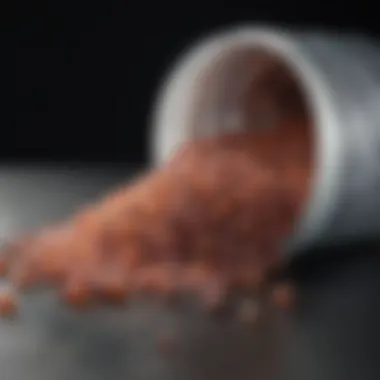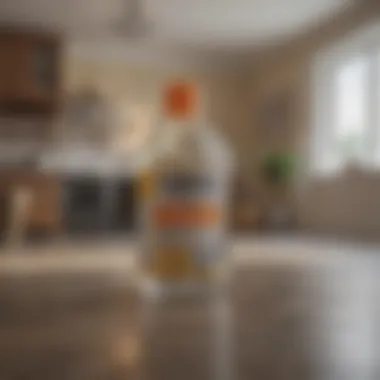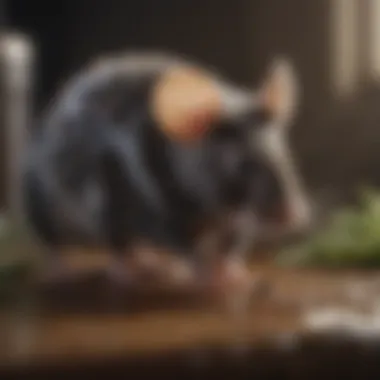Boric Acid: An Effective Solution for Mice Control


Intro
Mice infestations pose significant challenges in both residential and commercial settings, often causing damage to property and potential health risks. Effective control is crucial, not only to mitigate the immediate impact of such pests but also to prevent future occurrences. Boric acid emerges as a viable solution due to its unique properties that can effectively counteract mouse populations. This article explores these properties, providing insight into how boric acid compares with traditional rodenticides, as well as discussing its safe application methods and alternatives to pest control.
Pest Identification
Understanding the type of pest is essential for effective management. Mice are often the most common infestations that homeowners face.
Mice are small, typically gray or brown, with pointed snouts and long tails. They have a body length ranging from 2.5 to 4 inches, excluding the tail. A distinguishing feature is their large ears.
Signs and Symptoms of Infestations
Several signs can indicate a mice infestation:
- Droppings: Finding small, black pellets near food sources or nesting areas is one of the first signs.
- Gnaw marks: Mice tend to gnaw on various materials, leaving behind distinctive marks.
- Nests: Mice often build nests using shredded paper, fabric, or other soft materials.
- Nocturnal sounds: Scratching or scurrying noises, particularly at night, can indicate mouse activity.
Recognizing these signs early can help prevent a larger infestation.
Prevention Strategies
Taking proactive steps can significantly reduce the likelihood of mice entering your home.
Home Maintenance Tips for Pest Prevention
- Seal entry points: Inspect your home for cracks or holes, particularly around doors, windows, and the foundation. Use caulk or metal mesh to close gaps.
- Proper food storage: Store food in airtight containers to limit attraction. Keep countertops clean to minimize crumbs and spills.
- Remove clutter: Mice thrive in cluttered environments, which provide shelter and nesting materials. Keep storage areas organized and tidy.
Natural Deterrents and Barriers
There are several natural methods to deter mice effectively:
- Peppermint oil: The strong scent of peppermint is known to repel mice.
- Ultrasonic repellents: These devices emit high-frequency sound waves that are disturbing to rodents but inaudible to humans.
Implementing these strategies not only prevents mice but also enhances the overall living environment.
Treatment Options
Once mice invade, action is required. Treatment options range from chemical solutions to natural methods.
Overview of Chemical vs. Natural Treatments
Boric acid is a popular choice among both homeowners and pest control experts. Compared to traditional rodenticides, boric acid is often regarded as safer and more environmentally friendly. It disrupts the digestive systems of mice when ingested.
Step-by-Step Guides for DIY Treatments
- Identify infested areas. Look for droppings or other signs discussed earlier.
- Apply boric acid carefully. Use gloves to avoid skin contact and sprinkle boric acid in areas where mice are active.
- Monitor the area. Check for decreased activity and any remaining signs of mice.
Important: Always follow the manufacturer’s instructions when using any pesticide, including boric acid.
Boric acid is effective when used properly, but caution and respect for safety are paramount.
Finale
Boric acid stands out as a solution for managing mice populations, offering a balance between efficacy and safety when used appropriately. By developing a better understanding of mouse identification, preventative measures, and treatment options, homeowners can equip themselves with the knowledge necessary to tackle infestations head-on.
Understanding Boric Acid
Boric acid is a versatile compound that has gained recognition in pest control, especially for its efficacy against rodents like mice. Understanding its properties and applications can empower homeowners to tackle infestations responsibly and effectively. This section explores the fundamental characteristics of boric acid, tracing its history and illustrating how it impacts pest behavior. Each of these aspects contributes to a deeper appreciation of why boric acid may serve as an optimal solution in the battle against mice.
Chemical Composition and Properties
Boric acid, chemically known as BO3, is a colorless crystalline substance, often found in powder form. Its unique molecular structure contributes to its effectiveness in pest control. Mainly, it acts as a stomach poison to rodents, disrupting their bodily functions over time. In addition to its toxic properties, boric acid possesses fungicidal and insecticidal qualities, making it a multi-faceted tool in pest management.


When used in strategic applications, this compound can dramatically reduce pest populations. Its low solubility in water aids in retaining effectiveness in dry conditions, although it must be applied correctly to achieve desired results. Moreover, boric acid is not classified as a hazardous material, which highlights its appeal for household use.
Historical Background and Usage
The use of boric acid dates back centuries, initially utilized in antiseptics and as a mild pesticide. Its properties were recognized by ancient cultures, where it was used both medicinally and for agricultural purposes. Over time, its applications broadened, and it became a common household item.
In the pest control field, it emerged as a favored choice due to its safety when handled properly. Unlike many synthetic pesticides, boric acid is often seen as a natural alternative. Households have started to revert to traditional methods of managing nuisances, and boric acid fits this narrative well. Its historical significance as a safe yet effective pest deterrent cannot be overstated.
Mechanism of Action on Pests
The mechanism by which boric acid operates is both fascinating and effective. When ingested by rodents, it interferes with their digestive system, leading to dehydration and ultimately death. Additionally, boric acid disrupts the synthesis of crucial enzymes, which are necessary for survival.
Mice are particularly vulnerable because of their need to groom themselves frequently. As they consume food laced with boric acid, the powder adheres to their fur and skin. When they groom, they ingest further quantities of the toxic substance. This process can lead to successful control of the mouse population in residential areas.
Moreover, boric acid can appeal to mice's innate curiosity, encouraging them to consume it where traditional traps might fail. Using boric acid aligns with integrated pest management, focusing on effective and humane methods to keep homes free from unwelcome guests.
"Understanding how boric acid works is crucial for effective pest management. Its unique properties and mechanisms make it a formidable option in the realm of rodent control."
In summary, a thorough understanding of boric acid enriches the knowledge of those seeking pest control solutions. Its chemical composition, rich history of use, and specific mechanisms against pests offer valuable insights into the role it can play in a household setting.
Mice: A Common Household Pest
Mice are often seen as a persistent and common problem in many households. Their presence can lead to considerable discomfort and financial implications for homeowners. Understanding the behavior and characteristics of mice is crucial in addressing infestations effectively. The insights into mice can guide users, such as housewives and homeowners, to necessary preventative steps. This can reduce the risk of these pests invading living spaces and forming nests in unintended areas.
Identification and Behavior
Identifying mice is essential for effective control. Generally, the house mouse, Mus musculus, is what people encounter frequently. These rodents have small bodies, typically measuring about 3 to 4 inches long, with tails that almost equal their body length. Their fur is fine and usually light gray or brown, with lighter bellies.
Mice are primarily nocturnal, meaning they are most active during the night. This behavior can complicate detection, as they may enter homes unnoticed. They tend to travel along walls and in hidden areas, making it necessary to inspect those regions for signs of activity.
Health Risks Associated with Mice
Mice are not just a nuisance; they pose significant health risks as well. They are carriers of various diseases that can affect humans.
According to the Centers for Disease Control and Prevention (CDC), mice can transmit diseases such as Hantavirus, Lymphocytic Choriomeningitis (LCMV), and Salmonella through their droppings and urine.
Dealing with mouse infestations requires not only a physical removal strategy but also considerations for health implications. Contaminated food and surfaces can lead to illness, emphasizing the need for immediate action upon discovery.
Signs of Infestation
Detecting a mouse infestation early can help mitigate damage and health risks. There are several signs homeowners can look for, which include:
- Droppings: Mouse droppings resemble small grains of rice and are often found along pathways.
- Nesting Materials: Look for shredded paper, cloth, or other materials used by mice for making nests.
- Chewed Items: Mice gnaw on various materials, including wood, plastic, and wiring, leaving behind visible marks.
- Footprints or Urine Marks: These can be seen in areas where mice frequently travel, particularly in dusty or dark spaces.
By keeping an eye out for these indications, individuals can take timely precautions and apply appropriate pest control measures before problems escalate.
Advantages of Using Boric Acid for Mice Control
Boric acid has gained attention as a promising solution for mice control within households. Understanding its advantages is critical for homeowners seeking effective pest management strategies. The benefits of using boric acid can be categorized into several key areas: effectiveness, safety for humans and pets, and environmental impact.
Effectiveness Compared to Conventional Rodenticides
Boric acid's effectiveness stems from its unique mechanism of action. Unlike many conventional rodenticides, which may involve toxic chemicals, boric acid targets the stomach and nervous system of mice upon ingestion. Studies show that boric acid can lead to weight loss, dehydration, and eventually death in rodents. This action often occurs within a few days after the initial exposure, making it a potentially effective option where rapid results are desired. Boric acid's appeal is further enhanced by its ability to be less appealing for resitance development among pests, thus maintaining its effectiveness over time.
Safety for Humans and Pets
One of the primary concerns with rodenticides is the safety of household members, including pets. Boric acid is generally regarded as less hazardous than traditional poisons. When used properly, risk to humans and animals remains minimal. This safety factor is beneficial for families with children or pets that might unintentionally come into contact with pest control substances. However, it is vital to follow application guidelines strictly. Boric acid should be applied in areas inaccessible to pets or children to minimize any potential exposure.
Environmental Impact of Boric Acid


The environmental considerations of pest control methods are increasingly important. Boric acid has a relatively low toxicity to non-target wildlife, making it a suitable alternative for mindful homeowners. It decomposes naturally and does not accumulate in the ecosystem. When comparing boric acid to heavier synthetic rodenticides, its use can lead to a reduced risk of contaminating soil and water supplies. Furthermore, utilizing boric acid can increase ecological awareness and responsible pest management practices.
"Boric acid stands out for its effectiveness, safety, and environmental friendliness, making it a prime choice for pest control."
How to Use Boric Acid for Mice Control
Using boric acid for mice control is essential for homeowners looking for an effective method of pest management. This section aims to provide guidance on the proper techniques for using boric acid, emphasizing its effectiveness while ensuring safety and efficiency. Understanding how to prepare and apply boric acid adequately can greatly enhance its benefits in controlling mouse populations.
Preparation and Application
Preparation is a crucial step in using boric acid effectively. First, choose a boric acid product specifically designed for pest control rather than general use. This ensures the formulation is appropriate. Before application, clean the areas where mice are frequently seen. Remove any food sources or clutter that could attract rodents. Once the area is clean, follow these steps for application:
- Mixing the Solution: Dissolve boric acid powder in water to create a solution. The typical ratio is one part boric acid to ten parts water. For dry applications, sprinkle powdered boric acid around suspected entry points and nesting sites.
- Targeted Application: Focus on areas like baseboards, behind appliances, and in cracks or crevices. Mice tend to travel along walls, so placing the substance near these pathways increases its chances of being ingested.
- Use Bait Stations: If practical, integrate the boric acid with bait that attracts mice, increasing the likelihood they will consume it.
Recommended Dosage and Areas of Application
The recommended dosage of boric acid varies depending on the specific environment and the severity of the infestation. A general guideline is to use 1 to 2 tablespoons of boric acid in mouse-infested areas. Here are some specific recommendations:
- Inside the Home: Place boric acid in the kitchen, around garbage bins, and in other locations where food is stored.
- Basements and Attics: Check these locations thoroughly, as they can harbor nests. Apply boric acid in cracks and gaps to disrupt their habitat.
It is essential to monitor the effectiveness of your treatment and reapply as necessary, especially if you notice continued signs of mouse activity.
Safety Precautions During Application
While boric acid is generally safer than many conventional rodenticides, caution is still important. Here are key safety measures:
- Wear Protective Gear: During application, wear gloves and a mask to prevent irritation from powdered forms of boric acid.
- Keep Away from Children and Pets: Store boric acid in a secure location, out of reach of children and animals. Consider using bait stations that minimize access.
- Ventilation: Ensure good air circulation in enclosed spaces during application to avoid inhaling dust.
- Follow Instructions: Always read the label on the boric acid product for specific safety recommendations.
By focusing on the right preparation, dosage, and safety measures, users can utilize boric acid effectively to control mice populations. This approach not only enhances the effectiveness of the treatment but also ensures a safe home environment.
Limitations and Risks of Boric Acid
Understanding the limitations and risks associated with boric acid is crucial for effective mice control. While it offers a safer alternative to many conventional rodenticides, it is not without its downsides. Awareness of these issues helps in making informed decisions when managing mouse populations.
Potential Toxicity and Mishandling
Boric acid is often perceived as a less toxic option. However, it can still pose risks if not handled properly. For humans and pets, ingestion of boric acid can lead to symptoms such as nausea, vomiting, and abdominal pain. The degree of toxicity varies, but careful attention should be paid when placing boric acid in or around the home.
Moreover, storage of boric acid needs to be secure, away from children's reach. Mishandling can result in accidental exposure. It is recommended to use gloves when applying it and to thoroughly wash hands after contact. An important note is that while the substance is less hazardous in small amounts, excess exposure can still be harmful.
Effectiveness in Extreme Conditions
The efficacy of boric acid can also be affected by specific environmental conditions. Extreme humidity or excessive moisture can diminish its effectiveness. Boric acid attracts pests through its sugary properties, which may not be appealing under wet conditions. Mice might ignore bait stations if the area is not optimally dry. This means boric acid might need to be reapplied more frequently in such settings.
Additionally, temperature disparities can impact its performance. High heat may cause the boric acid to break down, making it less effective over time. Therefore, it is crucial to monitor the conditions of application to ensure maximum efficiency.
Resistance Development in Pests
Another significant concern with boric acid, similar to other pest control methods, is the potential development of resistance in mouse populations. Over time, pests can adapt to various control methods, including boric acid. This adaptation can lead to diminished effectiveness, requiring home owners to explore more aggressive measures. Thus, rotation of pest control strategies is necessary to prevent resistance build-up.
"Effective pest management includes understanding both the benefits and risks inherent in the methods employed."
By acknowledging these limitations, one can utilize boric acid thoughtfully and effectively in their pest control efforts.
Alternative Rodenticides and Control Methods
Rodent control is vital for maintaining health and hygiene in households. With various methods and products available, it's important to look at alternatives to traditional rodenticides. These alternatives offer unique benefits, considerations, and may even align better with the preferences of some homeowners. Understanding these options ensures effective control without significant risks to the environment, humans, or pets.
Comparison with Other Natural Remedies


Natural remedies often appeal to those seeking less chemical-based solutions for pest control. Many homeowners are cautious about using harsh chemicals, especially in households with children or pets. Common natural alternatives include peppermint oil, diatomaceous earth, and traps.
- Peppermint oil: This repellent is said to deter mice due to its strong scent. Spraying diluted peppermint oil around entry points may help keep them at bay.
- Diatomaceous earth: This powder works by causing dehydration in insects and rodents when ingested or when it clings to their fur. While effective, it requires careful application to ensure good coverage.
- Homemade traps: Some people prefer to set up manual traps using simple materials like a bucket and bait, which can be a humane option.
It’s worth noting that while natural remedies are appealing, they may not always be as effective as synthetic options. Results can vary widely, and persistent infestations may need a more robust approach, such as boric acid or professional treatments.
Mechanical Control Methods
Mechanical control methods involve physical traps and barriers to manage rodent populations. These methods are advantageous because they can be reusable and do not expose households to chemicals. The key types include:
- Snap traps: These are quick-kill traps that eliminate rodents instantly. They are designed to be set in areas frequented by mice to enhance effectiveness.
- Live traps: These traps capture rodents without killing them. Users must then release captured mice far from the home, which some may prefer for ethical reasons.
- Exclusion methods: This involves sealing gaps and openings to prevent mice from entering. Such methods can be preventive and highly effective over time.
Choosing mechanical methods might require some time and effort initially, but they can lead to long-term success without relying solely on chemicals.
Professional Pest Control Options
In cases where infestations escalate beyond personal control, engaging professional pest control services may be necessary. These experts bring advanced knowledge and resources to address infestations efficiently. The benefits of hiring professionals include:
- Comprehensive assessment: Pest control professionals can identify the extent of the infestation and assess factors that contribute to it.
- Tailored solutions: They provide a range of interventions suited to specific situations, including integrating chemical and non-chemical approaches.
- Long-term management: Professionals often offer follow-up services and advice on how to prevent future infestations.
However, it is crucial to research and choose a reputable pest control company to ensure that their methods align with your household values, especially regarding the use of chemicals.
In summary, exploring alternative rodenticides and control methods helps homeowners make informed decisions. These alternatives can complement or serve as substitutes for boric acid, providing varied approaches to manage rodent populations effectively.
Debunking Myths about Rodent Control
Understanding the various myths surrounding rodent control is crucial for homeowners and anyone dealing with mice infestations. Many misconceptions can lead to ineffective strategies or even worsen the problem. This section aims to clarify some common misunderstandings about boric acid and other pest control methods, helping to enhance knowledge on rodent management.
Common Misconceptions about Boric Acid
Many believe that boric acid functions solely as a poison, which is a simplification of its actual role. Boric acid does have toxic properties, but its effectiveness is much more about the physical mechanism by which it affects rodents. When ingested or contacted, it causes dehydration and digestive issues in mice, rather than acting swiftly like traditional poisons.
Additionally, some think that boric acid is unsafe for use around pets and children. In truth, when applied correctly and in appropriate amounts, boric acid poses low risk. However, it is important to ensure that it is placed in hard-to-reach areas to prevent unintended contact.
Understanding Rodent Facts vs. Fiction
There are many myths regarding rodent behavior that can lead to ineffective pest management. One well-known myth is that if mice are present in a home, it indicates poor hygiene. In reality, mice are attracted to shelter and food sources, not just dirt or mess. This means even the cleanest of homes can fall victim to an infestation.
Another common belief is that one can effectively eliminate mice with just one application of any pest control method. In fact, mice reproduce quickly, and a single approach rarely achieves complete eradication. Comprehensive pest management that includes multiple methods and ongoing monitoring is essential for successful outcomes.
Risks of Over-reliance on Certain Methods
Relying too heavily on any single method of rodent control may lead to other challenges. For instance, using only traps or baits can create a cycle of dependence that is unsustainable. If one method fails, the infestation may grow without consideration for an integrated approach.
Moreover, over-reliance on chemical solutions can lead to resistance. Mice may adapt to specific toxins, making them far less effective over time. It is critical to employ a combination of methods, such as mechanical traps and environmentally friendly solutions like boric acid, along with good sanitation practices.
"Effective rodent control is not about choosing one method, but rather a combination of strategic actions tailored to the environment."
Epilogue
Understanding the role of boric acid in pest control is vital for home and property management. This article highlighted several essential aspects regarding its usage against mice. By examining the chemical properties, effectiveness, safety, and application methods, we have provided readers with a comprehensive overview. Boric acid’s utility as a cost-effective and less hazardous alternative to conventional rodenticides stands out as a significant benefit. It allows for effective pest control without exposing households to the harsh chemicals often found in traditional products.
Summary of Insights on Boric Acid
Boric acid, known for its insecticidal properties, emerges as a capable solution for controlling mice populations. The insights provided demonstrate its multifaceted benefits.
- Effectiveness: Studies and empirical evidence show that boric acid disrupts the digestive systems of rodents, leading to humane eradication without causing immediate distress.
- Safety: When used correctly, boric acid poses minimal risks to humans and pets, especially compared to stronger chemical alternatives.
- Environmental Considerations: This method of pest control is less damaging to the ecosystem, as it integrates into natural decomposition processes.
Incorporating boric acid into pest control strategies represents a forward-thinking approach. The combination of safety, effectiveness, and environmental consciousness makes it a favorable option for mice management.
Final Thoughts on Pest Management Strategies
Choosing an effective pest management strategy requires a thoughtful analysis of Options. Boric acid is a promising option, but it should not be the sole strategy. A balanced approach that includes preventive measures and alternative methods maximizes success in rodent control. Consider the following:
- Prevent Entry: Seal cracks and openings in walls and foundations to keep mice out.
- Proper Food Storage: Keep food in airtight containers and clean up spills promptly.
- Monitoring: Regularly check for signs of infestation, allowing for quick action if needed.
Ultimately, integrating diverse pest management techniques fosters an environment less conducive to infestations. Boric acid, complemented by these additional strategies, can contribute toward homes that are both safe and pest-free.



